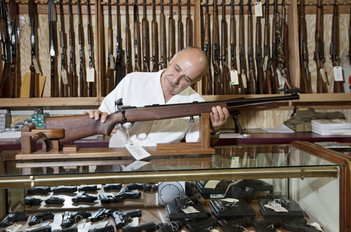Buying Used or Military Surplus Guns: What to Inspect (and How)
Oct 9th 2023
We’ve written before covering the virtues of buying used or military surplus firearms. Both instances give you a number of different potential advantages; buying used or surplus can furnish you with the ability to find an out-of-production firearm, and often at a really good price.
But buying used guns - like buying used anything - is not without its risks. It also requires you to be an uncommonly savvy shopper. But you can do it, and many have before you. Here are some things to look for when shopping for used or military surplus guns.
What to Look at Before Buying a Used or Military Surplus Gun
Found a new shop with a consignment of used firearms or military surplus guns? Here are a few things to look for.
(NOTE: When inspecting and manipulating a firearm during handling, always open the action, clear the firearm, and observe all safe firearm handling rules; keep your finger off the trigger and never point the firearm in an unsafe direction.)
- First, inspect the exterior of the firearm. Make sure all hardware is present, that the sights are there. Look for missing parts like sling mounts, screws, pins, trigger guards, etc. Check the condition of the wood stock. Is it in good condition, and does it still bear its finish? Or is it pitted, scratched, or damaged? Does it exhibit signs of discoloration or dry rot? Carefully inspect the receiver, action, and barrel. All metal components should be clear, unmarred, and unworn. Pitting and rust are concerns. Inspect the exterior of the barrel for signs of bulging; do not purchase a used firearm with a bulge in the barrel.
- Don’t be turned off by holster wear and other signs of superficial wear. A gun that looks worn might still be in perfect mechanical order.
- Before manipulating controls, perform the rattle-check. Holding the firearm securely, with both hands, rattle it gently. You shouldn’t hear anything inside or loose shaking or rattling around.
- For any firearm with an articulated action (lever, pump, bolt, etc.) rack the action open and ensure it opens, closes, locks, and cocks properly. The action should cycle smoothly and fluidly. It shouldn’t feel tight, gritty, or loose. Some shop owners will let you test feeding with snap caps. Ask them for permission and they may be happy to accommodate.
- If the firearm has a safety, engage and disengage the safety. When checking the trigger (see below) ensure that the safety prevents the trigger from releasing the sear while the safety is engaged.
- If the firearm feeds from a detachable magazine, remove the magazine and inspect it. The magazine body should be clean and free of rust, wear, dents, pitting, or discoloration. Ensure the follower is present. Then, test to see that the magazine inserts and catches easily; then, drop the magazine using the mag release. Ensure that all moving parts are in good order. NOTE: A firearm with a magazine in poor condition should not be a deal breaker since detachable mags can be easily replaced. We offer a wide range of rifle and pistol magazines for sale on our website and in our showroom.
- Always check a trigger before buying a used firearm - but always ask permission from the shop owner/seller before testing the trigger. If you get permission, ask for a snap cap and test the trigger. It should break cleanly, without too much creep or overtravel. A mushy trigger or one with loose creep or take-up is a bad thing, too.
- If handling a revolver with a double/single action, ask for permission to test both the single and double action of the trigger.
- If the exterior of the firearm and other moving parts is satisfactory, ask the shop owner for permission to check the chamber and bore with a bore light. Look at the mouth of the chamber for signs of corrosion or accumulated fouling. The barrel’s bore should be bright and shiny - like a mirror, with no fouling deposits, pitting, or debris accumulation. Barrels can be restored; to a point. Pitting, rust, and bulging can compromise a barrel past the point of repair. When inspecting a barrel, always inspect from the breech-end, unless inspecting a muzzleloader.
- If inspecting a muzzleloader, check for signs of rust on the exterior of the firearm as well as in the barrel. Black powder fouling is highly corrosive.
- When manipulating the lock of a black powder firearm, test to see that the half-cock function is operable and that the trigger does not release the lock when it is half-cocked.
- For shotguns with interchangeable chokes, ask to see if you can remove the choke tube. You don’t want to buy a shotgun with a seized choke.
- If all else is satisfactory but you still have qualms, ask the seller/shop owner if you can partially strip the firearm to check for signs of internal wear, corrosion, or damage. A full disassembly may not be necessary but a partial breakdown of some platforms can help put your mind at ease.

Hopefully, this short guide will have you inspecting used and military surplus firearms like a pro in no time.
Military Surplus Guns, Parts, Kits, and Rifle and Pistol Magazines for Sale
In addition to the military surplus guns we sell, we also carry a lot of replacement and upgrade gun parts, as well as rifle and pistol magazines for sale. On top of magazines for military firearms, we also carry mags for popular civilian models, including but not limited to Colt, Sig Sauer, Smith & Wesson, Rock Island, and many others.
Take a look through our online collection and get in touch with us if you have any questions.

